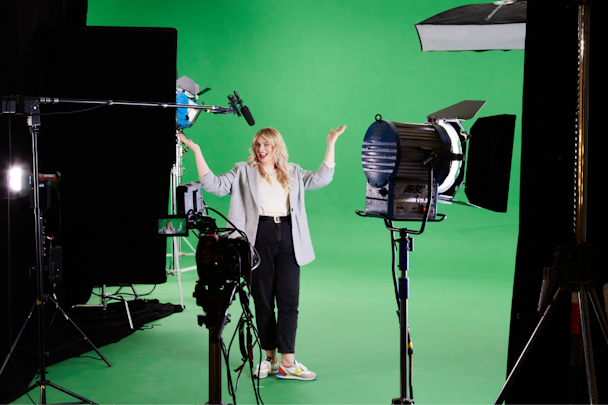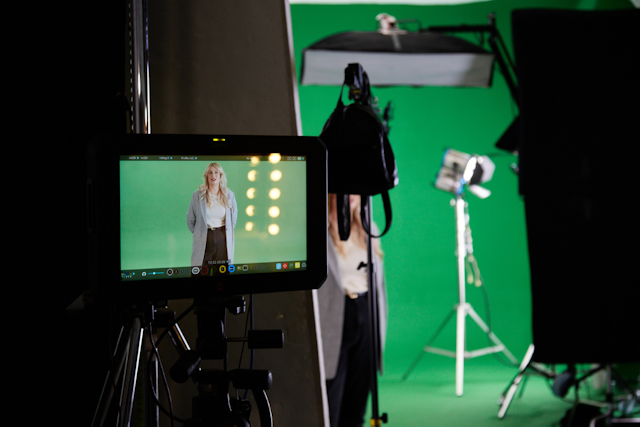Virtual production can make ads cheaper and sustainable, but is it accessible to all?
As part of our Tech Takeover deep dive, where we look at everything from AI to web3, we consider the barriers to entry for agencies wanting to use virtual production to make cheaper and more sustainable ads.

Powerhouse is hoping to offer virtual production services at an accessible price / Powerhouse
Virtual production methods are on the rise among creative and production agencies. When used properly, they can help aid scale by producing more assets in a shorter time, providing agencies with a way to meet client demand for content that can be used in addressable campaigns. Furthermore, by reducing the need for on-location shoots, they’re emerging as a key means of reducing the carbon cost of advertising.
The opportunity to add value and make savings led Scottish agency Leith to invest in virtual capabilities when it opened a new production base in Manchester last year, for example.
But getting to the point where an agency can take advantage of those efficiencies either by building an in-house studio or by using a third-party supplier requires time and money – two things that smaller agency businesses rarely have a surplus of.
Advertisement
Direct costs
Joel Spezeski is a cinematographer and creative technologist at Ginger Shots, a studio that specializes in ‘tabletop’ shots of products in ads. The company is part of ME Group, a production company based in Vietnam. He believes virtual production methods are “promising,” but integrating them properly into his work will take time.
“We don’t yet have these capabilities at a point we are pitching to clients,” he tells The Drum. “I agree that virtual production methods need not be restricted to only the largest companies. The techniques can offer significant creative opportunities and can be executed at reasonable cost.”
Client demand for such methods has been slow coming. The environmental benefits of reducing the length and size of domestic shoots aren’t yet driving customers to ask for virtual. “Most clients aren’t there yet,” says Spezeski, and the studio has mainly employed VP as a means to move away from printed backgrounds in product shoots – something the cinematographer says he hates.

Still, the potential is tempting, says Spezeski. “We have not seen much in the way of demand for virtual production services. All of the enquiries we’ve fielded so far have been more towards virtual sets for keynotes and events – broadcast type applications.
“All that said, if one has suitable creative, great pre-production planning and a capable and experienced team, virtual production can absolutely offer viable solutions at accessible costs.”
Content agency Powerhouse has been hoping to capitalize on that possiblity. The Leeds company has launched a new partnership with two other organzations, Xplor and Rebel Digital, to open a virtual production studio in West Yorkshire.
Agencies and brands can use the studio to benefit from cinema and premium TV-quality production for the “delivery of consistent high-quality content at scale,” says managing director Neil Adams. “Not only can we get more variety of shots in a smaller time period, we can create more types of content quickly, allowing us to create bespoke options to meet any client needs.”
Adams is keen to emphasize the creative possibilities that come with potential savings. Integrating post-production into real-time shoots or the ability to exercise total control over lighting, for example, means that “directors of photography can play God,” he says.
Advertisement
In London, Chris Shadrick, the chief strategy and growth officer of London creative indie Collective, says that his agency has found virtual production “accessible,” despite its size.
With a staff of just 35, big investments of time or cash must be carefully considered. He says the going rate among third-party studios offering virtual production services begins at around £20,000 a day. “It isn’t going to necessarily be cheaper than if you were doing a local shoot, but you’ve got shoots where there are multiple locations, international locations, then that would be more expensive than a VP shoot,” he explains.
There’s also the cost of any set-building to consider. Even with the smaller footprint of a virtual set designed for use alongside a green screen, Shadrick says the agency’s costs for building one come to £5,000-10,000.
Most modern digital cameras will do the job fine, but camera tracking systems can cost up to £10,000, says Adams. Some agencies, including Media.Monks India, have told us how they are opting for “efficient but not state-of-the-art trackers” while they get their studios up and running, with the aim of acquiring better equipment further down the line.
The primary benefit right now to smaller agencies, says Shadrick, is the time saved on larger jobs. “The benefit is the speed. If you think about a four to six week shoot, you could probably do that in a week [with VP]. You’re completely compressing that time.”
Suggested newsletters for you
Talent competition
Unreal Engine, the software used to create digital environments and objects, is essential. “It’s pointless without Unreal or a gaming engine because you need that background to be produced,” he says. The economics are different to those surrounding VP equipment, though.
Unreal is currently free to enterprises turning over less than £1m in gross revenue, but the salary of an engineer trained to use it can come to around £70,000, says Shadrick, and there is a “huge amount” of demand for those experienced in using the tech. “A lot of Unreal engineers come from the world of gaming,” where pay and benefits are competition.
He says that Collective sold itself to recruits because it could offer more creative possibilities than were available in the trenches of an AAA developer. “As an agency, we’re backing Unreal and we’ve made a strategic investment with an agency to do that, so we’ve brought in two specialist 3D technologists.”
Spezeski has run up against the same obstacle. “While the pool of folks who know how to do virtual production is rapidly growing, the fact remains that folks with the necessary skills are rare compared with conventional CGI,” he says.
Time investment
Price tags and wages aside, the biggest investment agencies may make is time – time needed to develop a product or proposition around virtual production methods.
Adams tells The Drum that most of its estimated £200,000 investment over two years went on billable hours needed to develop it as a product and make sure they understood what it could offer clients in the present. “The barrier to entry is learning,” he says.
For his part, Spezeski has been toying around with Unreal and camera trackers for three years. “I’ve been doing most of this R&D myself in my spare time and it has been a long journey. I’ve been learning Unreal Engine from scratch and I don’t have a background in CGI or 3D or games development.”
Furthermore, both Adams and Spezeski agree that agencies may need spend longer at the pre-production stage to make sure they can really find a use for the hundreds of assets that might be created. “Extra lead time is a necessity,” says the latter. “Understanding the limitations of a chosen workflow and working within those constraints at the creative stage are also critical to running Virtual Production with limited resources.”
Virtual production methods are, for creative agencies, in their infancy and Spezeski says software is only now catching up with the practical needs of Ginger Shots’ clients. “The toolset is also not very mature. It was only with the most recent UE 5.1 release that the rendering engine has become capable of the kind of rendering results we require.”
For more on the latest happenings in AI, web3 and other cutting-edge technologies, check out The Drum’s latest Deep Dive – AI to Web3: the Tech Takeover. And don’t forget to sign up for The Emerging Tech Briefing newsletter.

